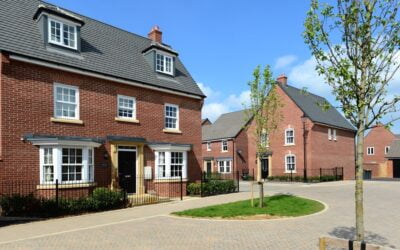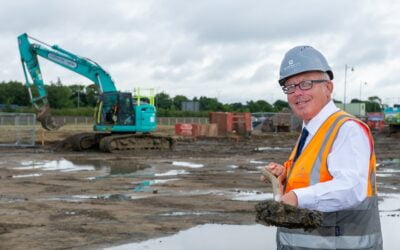2020 clean energy construction trends
The UK has led the world when it comes to tackling climate change, cutting emissions further than any other G7 country on a per person basis – 42% since 1990. While emissions have fallen since 1990, the UK has grown the economy by 72 per cent – an example that tackling climate change and growing prosperity can go hand in hand.
This means the government has committed over £3 billion to support low carbon innovation between 2015 and 2021 through the Clean Growth Strategy and the Industrial Strategy Challenge Fund.
Last year was the UK’s greenest ever year with more than 50% of electricity coming from low carbon sources. We have the biggest offshore wind capacity in the world, which is set to power a third of the UK’s electricity by 2030 – driven by £250 million investment from industry through our Offshore Wind Sector Deal launched in March 2019. When the sun is shining, solar panels can generate a quarter of our electricity and, by 2030, 70% of electricity could come from low carbon sources.
Alongside other developed countries, the UK pledged to provide at least £5.8 billion of International Climate Finance (ICF) between 2016 and 2020, placing us amongst the world’s leading providers of climate finance. ICF helps developing countries mitigate and adapt to the impacts of climate change, reduce deforestation and pursue clean economic growth. Since 2011, ICF has given 17 million people access to clean energy and helped 47 million people adapt to the impacts of climate change.
But with more to do, during last year’s Green GB Week independent climate experts, the Committee on Climate Change (CCC), were asked for advice on setting a date for achieving net zero emissions across the economy.
In May 2019, the CCC published its advice recommending a 2050 net zero emissions target and in June legislation was laid to put the UK on the path to become one of the first major economies to set a net zero emissions target in law. This will end the UK’s contribution to global warming and ensure we continue to be a world leader in tackling climate change.
On this subject we talked to Dr Matthew Trewhella, managing director of Kensa Contracting, as he explores the 2020 construction trends poised to help the UK government reach its 2050 net-zero carbon targets.
With the introduction of a Future Homes Standard mandating the end of fossil-fuel heating systems in all new build homes from 2025, housebuilders, planning, and building control are in a prime position to encourage low-carbon developments utilising eco-friendly building techniques and innovations in renewable technology to achieve our carbon ambitions.
Lowering carbon
The Future Homes Standard, effectively the follow up to the “ban the gas boiler” announcement, sets out what we can expect from our buildings from 2025. And how we are going to get there is notably the “transitional arrangements” in the proposed Future Homes Standard, which could see an almost overnight ban on oil, LPG and electric as soon as mid-2020; under the Standard gas will get much harder and heat pumps many times easier to introduce into new-build homes.
The proposed new SAP calculation is intended to allow assessment of the effects of the Future Homes Consultation proposed options. One of the headline-grabbing proposals in SAP 10.1 is the proposed carbon factor for electricity at 0.136 – this will mean ground source heat pumps have carbon factors of 0.030 – 0.045 compared to a gas boiler at 0.23. That’s a saving of more than 80% in carbon emissions just by switching heating to ground source heat pumps.
With councils across the country declaring climate emergencies, many of which commit to carbon-neutral targets ahead of the UK’s 2050 ambition, a growing number of new build developments are already embracing the low-carbon approach.
In adherence to the Committee for Climate Change’s recommendation that homes should make use of low-carbon sources of heating, in particular, electrically-powered heat pumps that produce no point-of-use emissions, and the new National Design Guide, which singles out ground source heat pumps and district heating systems as recommended heating technology, Bristol is witness to a number of new build schemes utilising this ultra-low carbon, non-air polluting, and low-cost heating solution to support its 2030 carbon neutral pledge.
133 new homes at Ashton Rise are being built by Bristol City Council using the high-efficiency Sig iHouse solution, and heated by individual Kensa ground source heat pumps connected to a shared ground loop array of boreholes. The installation would see each home making lifetime carbon savings of 30 tonnes compared to individual gas boilers, whilst also removing all local NOx emissions, ensuring local air quality is not impacted by the choice of heating system.
Across the city, a further 50 affordable homes are being constructed to PassivHaus standards by United Living in partnership with United Communities and the Bristol Community Land Trust. The energy efficient ‘self-finish’ properties will each feature a mini Kensa Shoebox ground source heat pump connected to an ambient shared ground loop array. Complementing the low-carbon ground source heat pumps will be a MVHR (mechanical vented heat recovery) system, making the homes even more energy efficient and further lowering fuel bills for the residents. The homes will be constructed using a single skin Porotherm block, cutting construction time and delivering improved thermal properties over traditional construction. Solar PV panels further reduce costs, whilst supporting a green transport plan which features electric car charging points, a car share scheme and improved pedestrian and cycle access. Communal green space around the homes is also being created with a dedicated and protected green corridor for biodiversity and wildlife including bats, birds, bees and other insects.
Evidently the push by local planning authorities to place energy efficiency and carbon saving requirements on buildings that go beyond the requirements of the national building regulations is resulting in some ground-breaking ultra-low carbon, energy efficient developments. Two notable examples are:
Bristol City Council requires developers to reduce CO2 emissions by 20% and to follow a heat hierarchy that encourages renewable and low carbon heating.
The Greater London Authority requires developers to reduce CO2 emissions for new developments by 35% (10% must be from fabric improvements) compared to current building regulations.
The Future Homes Standard consultation proposes reductions of 20% (option 1) or 31% (option 2) in CO2 emissions for all new dwellings, nation-wide. However, it is also consulting on whether to remove the ability for local planning departments to impose deeper reductions via the planning process. This threatens the planning process being a major influence to impact CO2 emissions and achieve the UKs zero-carbon targets.
The London Energy Transformation Initiative (LETI) views the Standards proposals for Part L 2020 as a backward step ‘in a climate where we need a huge leap forward’, stating that ‘local authorities will lose the ability to meet their climate emergency zero carbon commitments if they are stripped of their powers to go above and beyond the new Part L’. Whilst the Future Homes Standard offers many significant highlights, the lowlight of lower carbon compliance targets is troubling. Kensa has addressed these in its response to the consultation, but if you wish to share your views and influence the consultation go to LETI and join the debate at https://www.leti.london/.
Ground source heat pumps
By connecting new developments to a ‘fifth generation’ shared ground loop array feeding individual ground source heat pumps in each new home, housebuilders are not only delivering a sustainable infrastructure to rival and replace the gas grid, they are providing a long-term low-cost low-carbon heating, and cooling, solution.
The rapid recent decarbonisation of the electricity grid and the high efficiency of ground source heat pumps now means that this route to the large-scale electrification of heating shows significantly more promise than the decarbonisation of the gas grid. Let’s explore three innovations which coupled with ground source heat pumps will enable this rapid transformation to take place.
Smart controls
There is a slightly unfortunate trend towards calling anything that is Wifi enabled “Smart”. While it might be more convenient to program a thermostat using your phone/tablet rather than pressing buttons on the thermostat, it is hard to see why this deserves to be called Smart. For a system to be truly smart, it should perform optimisation autonomously – with minimal input from users.
If done correctly, the smart revolution could be the essential key to a lower carbon future. Management of the electrical grid with variable demands has never been simpler – consider the classic Coronation Street ending rush for the kettle. A further level of complexity is added by the variability of renewable generation supply from wind, solar, wave and tidal.
The traditional solution would be to build additional generating capacity to over-produce and then turn off when not needed. However, the stable source temperature of ground source heat pumps makes them well suited to running when the grid can best support it.
If properly synchronised, smart control of millions of devices such as ground source heat pumps, electric vehicles and many others will allow the grid to function correctly without the need for over generation. Combined with the low electricity consumption of ground source heat pumps, this will save billions of pounds of capital investment in future generating capacity.
Consumers will also benefit as smart metering is giving suppliers the ability to charge consumers different prices at different times of day to reflect the availability of energy. Smart controls will allow householders to automatically take advantage of these dynamic tariffs to run their ground source heat pumps when prices are lowest – our modelling shows savings of 25-40% are achievable right now. Better still, lower priced times of day typically coincide with lower carbon grid electricity.
Cooling
Warmer summers, improved insulation, larger windows and urban heat islands are combining to increase the need for cooling, which is unhelpful in the fight against climate change. Traditional air conditioning actually makes the situation worse because all the heat taken out of the buildings is pumped into the air around the city, which exacerbates the need for cooling.
A ground array with an ambient temperature district heating loop makes an excellent source of cooling – the by-product of extracting heat from the ground all winter is a large area of pre-chilled ground which is conveniently piped to each property (heat pump). Passive cooling can therefore be provided at the extremely low cost of running a small circulating pump. Even better, the heat that you take out of each property is reintroduced into the ground, which improves the heat pump heating efficiency the following winter.
For properties that need even more cooling, it is simple to reverse the heat pump hydraulic flows so that the heat pump actively cools the property and sends the waste heat into the ground.
PV-T panels
Solar panels that combine photovoltaic (PV) cells and thermal (T) water heat exchangers have been around for a while, yet their full potential can be realised by combining them with a ground array. In summer, the ground array cools the panels from 40-50oC down to 15-25oC, which increases the efficiency of the photovoltaic panels by 15-25%. The heat taken from the panels re-charges the ground array which increases the efficiency of the heat pumps by 10-20%. Combining three renewable technologies in this way is a win-win-win, which improves the efficiency of each technology independently and results in a more efficient overall system, bill reductions and carbon reductions.
Timescales
These innovative construction trends all take advantage of existing technology but combine them in ways that bring huge benefits to the decarbonisation of heat. They are ready to go and future-proofed which means they can be deployed now with no regrets and their benefits will increase with time as the electricity grid evolves and decarbonises.




